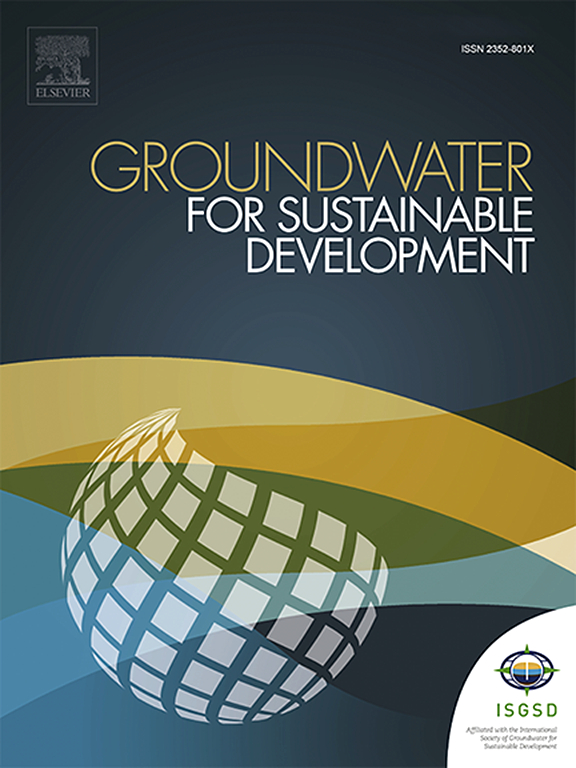Groundwater modelling assessment of a coastal agriculture climate change adaptation strategy incorporating green infrastructure: An Indus Delta case study
IF 4.9
Q2 ENGINEERING, ENVIRONMENTAL
引用次数: 0
Abstract
In many parts of the world, agricultural productivity is being undermined by soil salinisation. For the semi-arid to arid coastal areas of the Indus Basin in Sindh, Pakistan, salt transport into the crop root zones is enhanced by high evapotranspiration rates and the prevalence of shallow watertables. Surface water supply at this downstream end of the basin is insufficient to flush out salt build-up and the use of groundwater of marginal quality contributes to salinity accumulation. Seawater intrusion is further exacerbating these salinisation trends. To improve understanding of how these inter-related trends are impacting groundwater, we developed a MODFLOW 2005 model for a case study area in Sindh encompassing the Pinyari Canal Command Area (CCA) and coastal district of Sujawal. The SSP2-4.5 and SSP5-8.5 climate change scenarios were simulated to understand possible future outcomes from rising sea levels and reduced canal water supplies and their consequential impacts up to 2100. We then simulated a mix of adaptation strategies, including transforming cropping systems towards water efficient crops, and use of green infrastructure as a nature-based solution to build resilience by mitigating impacts from climate change along the coastal belt. However, even with these adaptations, our assessment suggested that waterlogging and salinity will only be marginally reduced, while salinity mobilisation under climate change will accelerate. The looming threats from climate change will thus require water and land managers to bolster green infrastructure with other mitigation strategies that rely on grey infrastructure, and to modify how they implement this mix of adaptation and mitigation strategies to ensure they are co-developed with coastal communities affected. Such a co-development approach is needed to ensure communities who continue to live in such semi-arid to arid coastal areas are engaged in ways that build their resilience and ongoing livelihood sustainability.

包含绿色基础设施的沿海农业气候变化适应战略的地下水模拟评估:以印度河三角洲为例
在世界许多地方,土壤盐碱化正在削弱农业生产力。在巴基斯坦信德省的印度河流域半干旱至干旱的沿海地区,高蒸散速率和普遍存在的浅地下水位加强了盐进入作物根部区的运输。盆地下游的地表水供应不足以冲掉盐的积聚,而使用质量较差的地下水导致了盐的积聚。海水入侵进一步加剧了这些盐碱化趋势。为了更好地理解这些相互关联的趋势是如何影响地下水的,我们为信德省的一个案例研究区域开发了MODFLOW 2005模型,该区域包括Pinyari运河指挥区(CCA)和Sujawal沿海地区。模拟了SSP2-4.5和SSP5-8.5气候变化情景,以了解海平面上升和运河供水减少可能带来的未来结果及其对2100年的影响。然后,我们模拟了一系列适应策略,包括将种植系统转变为节水作物,以及利用绿色基础设施作为一种基于自然的解决方案,通过减轻沿海地带气候变化的影响来建立抵御能力。然而,即使有了这些适应措施,我们的评估表明,内涝和盐度只会略微减少,而气候变化下的盐度动员将会加速。因此,迫在眉睫的气候变化威胁将要求水和土地管理者利用依赖于灰色基础设施的其他缓解战略来支持绿色基础设施,并修改其实施这种适应和缓解战略组合的方式,以确保它们与受影响的沿海社区共同开发。需要采取这种共同发展的方法,以确保继续生活在半干旱至干旱沿海地区的社区能够以建立其复原力和持续生计可持续性的方式参与其中。
本文章由计算机程序翻译,如有差异,请以英文原文为准。
求助全文
约1分钟内获得全文
求助全文
来源期刊

Groundwater for Sustainable Development
Social Sciences-Geography, Planning and Development
CiteScore
11.50
自引率
10.20%
发文量
152
期刊介绍:
Groundwater for Sustainable Development is directed to different stakeholders and professionals, including government and non-governmental organizations, international funding agencies, universities, public water institutions, public health and other public/private sector professionals, and other relevant institutions. It is aimed at professionals, academics and students in the fields of disciplines such as: groundwater and its connection to surface hydrology and environment, soil sciences, engineering, ecology, microbiology, atmospheric sciences, analytical chemistry, hydro-engineering, water technology, environmental ethics, economics, public health, policy, as well as social sciences, legal disciplines, or any other area connected with water issues. The objectives of this journal are to facilitate: • The improvement of effective and sustainable management of water resources across the globe. • The improvement of human access to groundwater resources in adequate quantity and good quality. • The meeting of the increasing demand for drinking and irrigation water needed for food security to contribute to a social and economically sound human development. • The creation of a global inter- and multidisciplinary platform and forum to improve our understanding of groundwater resources and to advocate their effective and sustainable management and protection against contamination. • Interdisciplinary information exchange and to stimulate scientific research in the fields of groundwater related sciences and social and health sciences required to achieve the United Nations Millennium Development Goals for sustainable development.
 求助内容:
求助内容: 应助结果提醒方式:
应助结果提醒方式:


